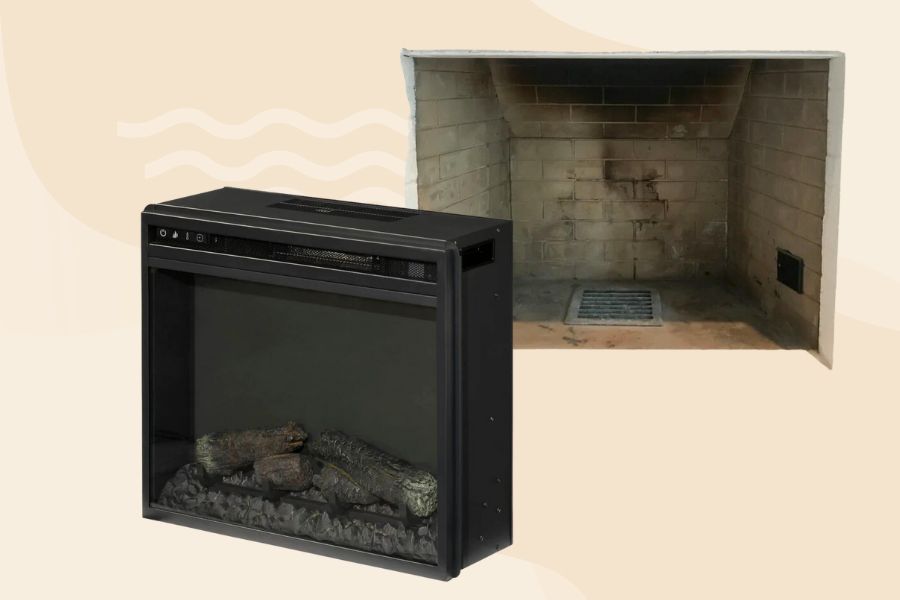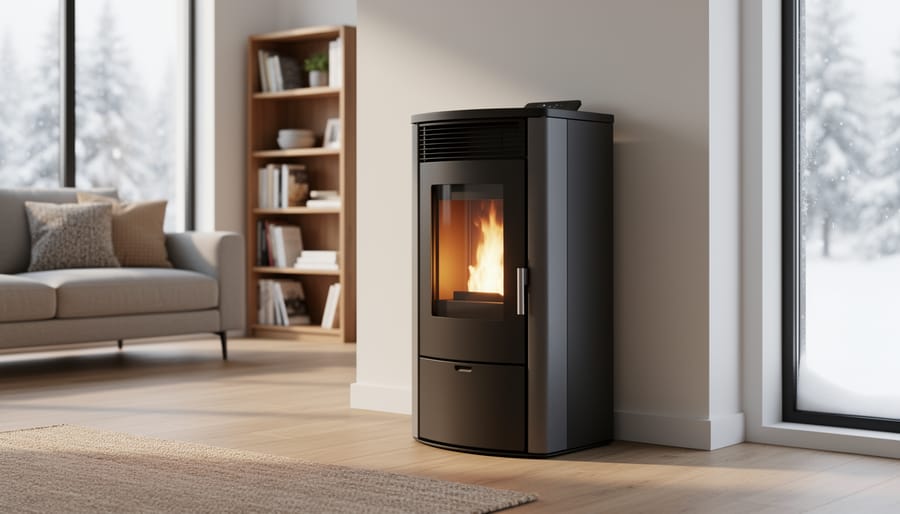Removing a fireplace insert is an important task that may be necessary for various reasons, such as upgrading to a more efficient model, conducting maintenance, or making changes to your fireplace.
It’s crucial to approach this process with caution and follow proper steps to ensure a safe and successful removal.
This comprehensive step-by-step guide will provide detailed instructions for removing different types of fireplace inserts, including wood-burning, gas, and electric inserts. You can confidently remove the insert from your fireplace by following these instructions carefully.
How to Remove a Wood-Burning Fireplace Insert?
Due to its design and installation, removing a wood-burning fireplace insert requires specific steps. To begin, it’s essential to familiarize yourself with the type of wood-burning insert you have and understand its components.
We will guide you through the necessary preparations and provide step-by-step instructions for disconnecting utilities, removing trim, detaching the insert, and ensuring safety throughout the process.
By following these instructions carefully, you can safely remove a wood-burning fireplace insert.
Things You’ll Need
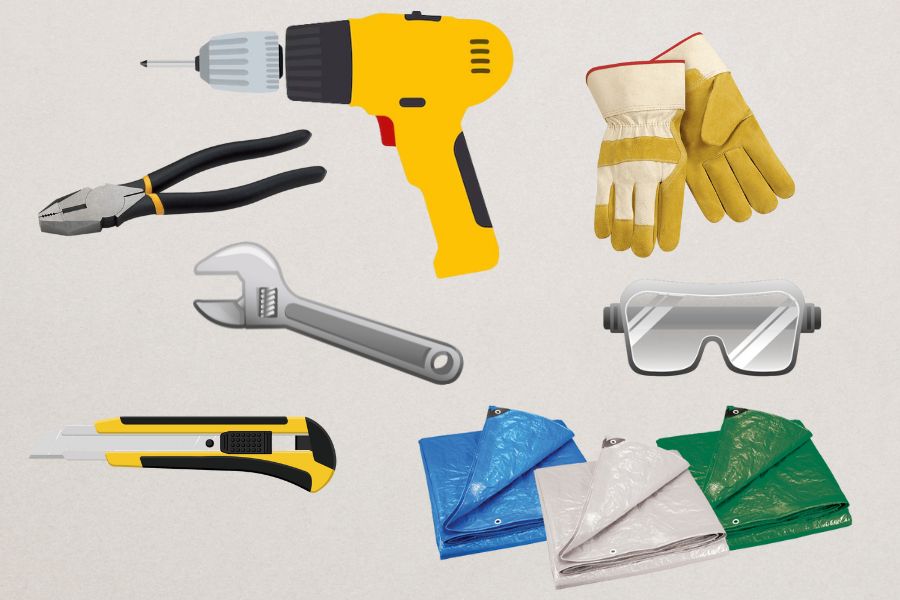
Before you begin the removal process, gather the necessary tools and equipment. Here are the items you’ll need:
- Screwdriver or drill: For removing screws and fasteners.
- Pliers: Useful for gripping and turning components.
- Wrench: Helps in loosening and tightening connections.
- Utility knife: Useful for cutting any caulking or adhesive materials.
- Protective gloves: Essential for hand protection during the removal process.
- Safety goggles: Protect your eyes from dust, debris, or flying particles.
- Drop cloth or tarp: Provides a protective covering for the surrounding area.
These readily available tools will make the removal process more convenient and efficient.
Remove the Trim
The trim surrounding the fireplace insert needs to be removed before you can proceed with the removal process. This step is essential as it allows access to the fasteners and screws that hold the insert in place.
Using a screwdriver or drill, carefully remove the screws or fasteners securing the trim. Take your time to ensure that you don’t damage the surrounding materials. Once the trim is detached, set it aside in a safe place for reinstallation later.
Cost to Remove Wood-Burning Fireplace Insert
The cost to remove a wood-burning fireplace insert can vary depending on various factors. On average, homeowners can expect to spend between $500 and $1,500 for removal.
However, the actual cost will depend on factors such as the complexity of the removal, the location and accessibility of the fireplace insert, and any additional work required, such as repairing or modifying the chimney or surrounding structure.
It’s important to note that these costs are for the removal of the insert itself and do not include any installation or replacement expenses.
Cost to Remove a Gas or Electric Fireplace Insert
The cost to remove a gas or electric fireplace insert can vary depending on several factors. On average, the cost ranges between $300 and $800.
However, the specific cost will depend on factors such as the complexity of the removal process, the type of fireplace insert, the location of the insert, and any additional work required, such as repairing or modifying the surrounding structure.
How to Remove an Electric Fireplace Insert

Removing an electric fireplace insert requires careful attention to electrical connections and safety precautions. However, here are some general steps to help you with the removal process:
- Start by unplugging the electric fireplace insert from the power source. Locate the power cord and safely disconnect it from the outlet or electrical connection.
- Once the power is disconnected, carefully remove any decorative elements or trim surrounding the insert. Use a screwdriver or other appropriate tools to detach any screws or fasteners.
- After removing the trim, you may need to detach any additional components such as a decorative faceplate or glass panel. Refer to the manufacturer’s instructions for specific guidance on removing these elements.
- With the decorative elements removed, you can access the electrical connections. Take note of how the wires are connected and use caution when handling the electrical components. Disconnect the wires according to the manufacturer’s instructions.
- Finally, once all the electrical connections are safely disconnected, you can carefully slide or lift the electric insert out of the fireplace cavity. Be mindful of its weight and have someone assist you if necessary.
It’s important to handle electric fireplace insert components with care and consider consulting a professional electrician if you have any doubts or concerns about the removal process.
How Much Does It Cost to Remove Each Type of Fireplace Insert?
The cost to remove different types of fireplace inserts varies based on factors such as labor charges, disposal fees, and additional services required. Here’s a breakdown of the estimated costs for removing each type:
- Wood-burning Fireplace Insert: Cost considerations include labor charges, disposal fees, and any extra services needed. Consulting professionals experienced in wood-burning insert removal will provide accurate cost estimates.
- Gas Fireplace Insert: Removal involves factors like gas line disconnection, ventilation, and potential repairs. Costs may include labor charges, gas line work, disposal fees, and necessary modifications. Consulting professionals will provide a comprehensive cost estimate.
- Electric Fireplace Insert: Costs depend on electrical complexities, professional assistance, and safety precautions. Electricians or technicians experienced in electric insert removal can provide accurate cost estimates.
These estimates are general and can vary depending on your specific circumstances and location.
Is a Fireplace Insert Heavy?
The weight of a fireplace insert can vary depending on its size, materials, and construction. Wood-burning and gas fireplace inserts tend to be heavier, ranging from 100 to 600 pounds or more, depending on the specific model and materials used. Electric fireplace inserts are generally lighter, weighing around 50 to 100 pounds.
Taking precautions is important to ensure your safety when removing a heavy fireplace insert. It is advisable to seek assistance from another person to aid in lifting and carrying the insert, particularly if it is notably heavy.
Unplug The Electric Insert
Before starting the removal process for an electric fireplace insert, it’s crucial to unplug it from the power source. This step ensures your safety and prevents any electric fireplaces
mishaps during the removal process.
To unplug the electric insert:
- Locate the power cord connected to the insert.
- Follow the cord to the outlet or electrical connection.
- Safely disconnect the plug from the outlet or disconnect the wiring if it is hardwired.
Always handle electrical connections carefully and make sure to fully disconnect the power before proceeding with the removal process.
Cleaning and Maintenance Tips
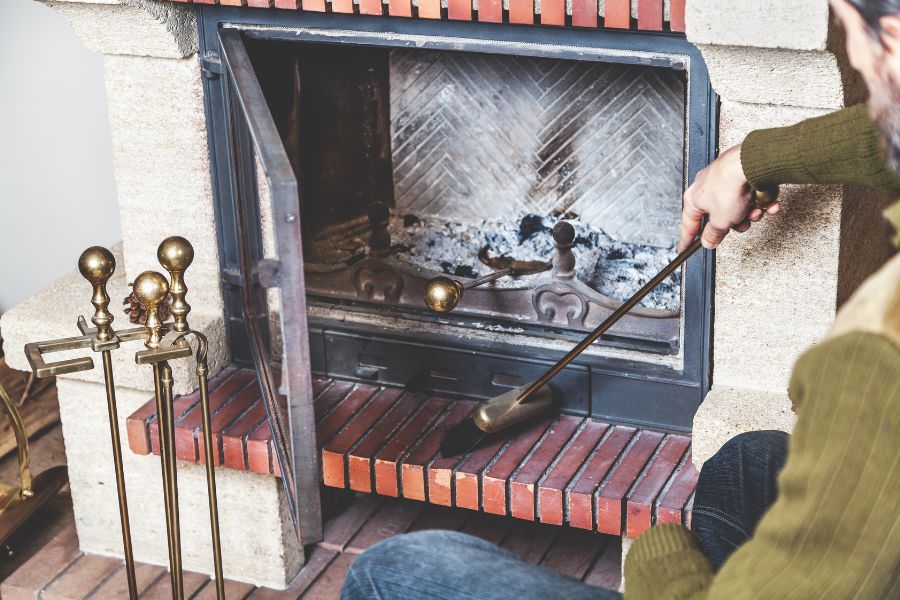
Cleaning and maintaining your fireplace insert is essential for optimal performance and longevity. After removing the insert, take the opportunity to follow these tips:
- Clean the Fireplace Cavity: Remove debris, ash, and soot using a vacuum cleaner or brush. Ensure any hot embers are extinguished before cleaning.
- Inspect the Chimney: Check for damage or blockages in the chimney and clear any obstructions. Consider professional chimney cleaning and inspection.
- Check the Flue: Confirm the proper operation of the flue and address any blockages or damage.
- Clean the Glass or Doors: Use a glass cleaner or vinegar-water mixture to clean the glass doors, removing dirt and residue.
- Check Seals and Gaskets: Inspect and replace worn-out seals for insulation and energy efficiency.
Regular cleaning and maintenance promote a well-functioning fireplace and reduce potential hazards.
Can I Replace An Electric Fireplace Insert?
If you have an existing electric fireplace insert that is outdated, damaged, or no longer meets your needs, you can replace it with a new one. The process typically involves removing the old insert and installing the new one in its place.
However, it is important to ensure compatibility between the new insert and the existing electrical connections, dimensions, and design of the fireplace.
Types of Fireplace Inserts
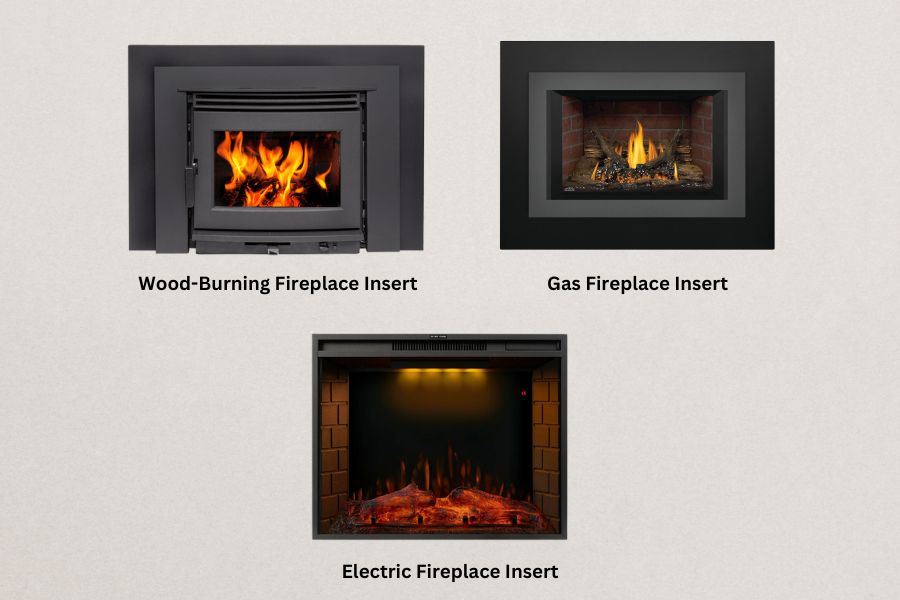
Different types of fireplace inserts are available, each with its own characteristics and advantages. Here, we’ll provide an overview of the three main types:
- Wood-Burning Fireplace Insert: This type of insert is designed to fit into an existing fireplace cavity and uses wood as the fuel source. Wood-burning inserts provide efficient heat output, can be aesthetically pleasing, and create an authentic fireplace experience. They require regular maintenance, including cleaning the chimney and disposing of ashes.
- Gas Fireplace Insert: Gas inserts are fueled by natural gas or propane. They offer convenient heat control, easy operation, and can provide a realistic flame effect. Gas inserts are known for their efficiency and clean-burning nature. They require professional installation and should be regularly inspected for safety.
- Electric Fireplace Insert: Electric inserts are powered by electricity and require no venting. They are easy to install, operate, and offer flexibility in terms of placement. Electric fireplace inserts often feature adjustable flame effects and heat settings. They are popular for their convenience, low maintenance, and versatility.
Each type of fireplace insert has its own benefits and considerations. Consider your heating needs, available fuel sources, installation requirements, and personal preferences when choosing the right insert for your home.
How Do You Remove a Wood Stove Fireplace Insert?
Removing a wood stove fireplace insert follows a similar process to removing a wood-burning fireplace insert. Here are the steps to remove a wood stove fireplace insert:
- Disconnect Utilities: If applicable, shut off the gas supply and unplug any electrical connections to ensure safety during removal.
- Remove Trim and Fasteners: Carefully detach the trim surrounding the wood stove insert. Use a screwdriver or drill to remove any screws or fasteners securing the trim.
- Detach the Stove From the Flue: Loosen any connections between the stove and the flue. This may involve removing screws, bolts, or clamps. Ensure proper support is in place to prevent the stove from falling when disconnected.
- Slide or Lift the Wood Stove Out: With the trim and connections removed, carefully slide or lift the wood stove out of the fireplace cavity. It may be heavy, so it’s advisable to have someone assist you to avoid strain or accidents.
How to Remove a Fireplace Insert (Step by Step)
- Gather the Necessary Tools and Equipment: Before starting, gather the tools and equipment you’ll need, such as screwdrivers, wrenches, gloves, safety goggles, and dolly or lifting straps if necessary.
- Disconnect Utilities: If applicable, turn off the gas supply and unplug any electrical connections. Ensure that the fireplace and surrounding area are safe before proceeding.
- Remove Trim and Fasteners: Carefully detach any trim or decorative elements around the fireplace insert. Use appropriate tools to remove screws, nails, or fasteners securing the trim.
- Disconnect Electrical and Gas Connections: If you have an electric fireplace or gas-powered, carefully disconnect the electrical and gas connections according to the manufacturer’s instructions. Pay attention to the connections of wires or pipes to ensure proper reinstallation or to facilitate the installation of a new insert if desired.
- Prepare for Lifting: If the fireplace insert is heavy, enlist the help of someone to assist you with the lifting process. Use proper lifting techniques and, if necessary, employ lifting equipment such as a dolly or straps to safely move the insert.
- Lift or Slide the Insert Out: With the assistance of your partner, carefully lift or slide the fireplace insert out of the cavity. Move slowly and steadily, ensuring you control the weight and movement of the insert.
- Clean and Inspect the Fireplace Cavity: Once the insert is removed, take the opportunity to clean the fireplace cavity. Remove any debris, ash, or soot, and inspect the interior for any signs of damage or wear.
- Dispose of the Old Insert: Properly dispose of the old fireplace insert according to local regulations and guidelines. Some materials may be recyclable, while others may need to be disposed of as waste.
Remember to exercise caution and prioritize safety throughout the removal process. If you’re unsure or uncomfortable with any step, consider seeking professional assistance to ensure a smooth and safe removal.
How Much Does It Cost to Remove a Wood-Burning Insert?
The cost of removing a wood-burning insert can vary depending on various factors. Generally, the cost ranges between $500 and $1,500. =
However, several elements can influence the overall cost. These factors include the removal process’s complexity, the fireplace insert’s location, and the project’s specific requirements.
You may incur additional expenses in case structural modifications are required or if specialized equipment is necessary for the removal. It is advisable to consult with a professional and obtain multiple quotes to get a more accurate estimate based on your specific circumstances.
Fireplace Insert Removal Cost Breakdown
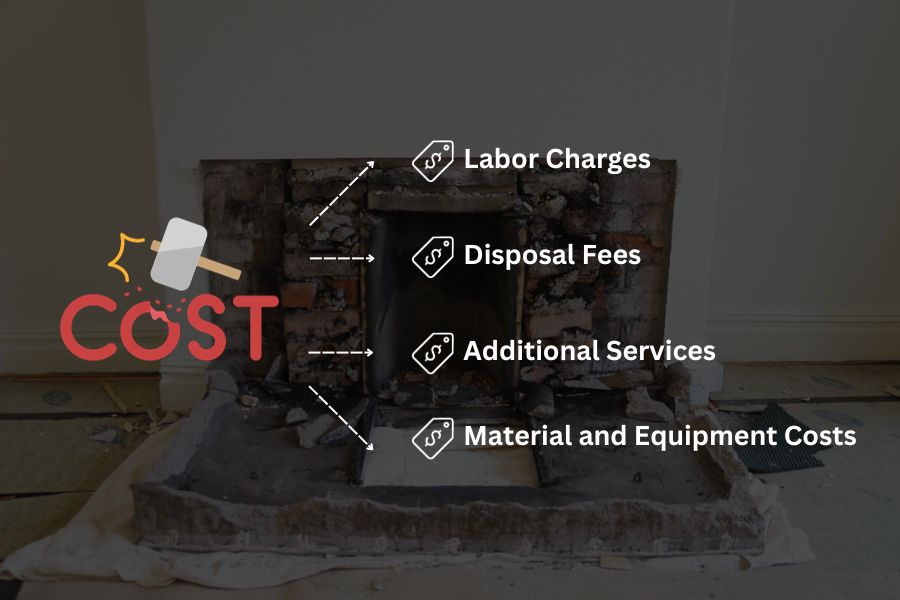
The cost to remove a fireplace insert can vary depending on various factors. Here’s a breakdown of the main cost components:
- Labor Charges: The cost of professional labor is typically the most significant component. Labor charges are influenced by factors such as the removal’s complexity, the fireplace’s location, and local labor rates. Hiring professionals ensures a safe and efficient removal but comes at a higher cost compared to a DIY approach.
- Disposal Fees: Some jurisdictions impose disposal fees for old fireplace inserts or have specific guidelines for their disposal. These fees can vary depending on local regulations. Contact local waste management authorities to determine if any disposal fees apply.
- Additional Services: If additional services are required, such as chimney cleaning, repairs, or modifications, they will incur extra costs. The extent and complexity of these services will determine the final price.
- Material and Equipment Costs: If you choose to remove the fireplace insert yourself, you may need to purchase or rent specific tools or equipment. These materials and equipment costs should be factored into the overall cost.
To determine the exact cost, experts suggest obtaining quotes from multiple professionals or contractors who have experience in fireplace insert removal.
What Factors Influence the Cost to Remove a Fireplace Insert?
Several factors can influence the cost of removing a fireplace insert. The complexity of the removal process plays a significant role, as more intricate installations may require additional time and labor.
The type of fireplace insert, whether it’s a wood-burning, gas, or electric insert, can also impact the cost. Gas and electric inserts may involve disconnecting gas lines or electrical wiring, which can add to the complexity and cost of the removal. The accessibility of the fireplace and its location within the home are also considerations.
If the fireplace insert is located on an upper floor or in a hard-to-reach area, it may require specialized equipment or additional manpower, affecting the overall cost. Additionally, the presence of any structural modifications or repairs needed after removal can contribute to the cost.
How Do I Choose an EPA-Approved Wood Fireplace Insert?
Choose an EPA-approved wood fireplace insert for efficiency and environmental compliance. Look for EPA-certified models designed to burn wood efficiently, reducing fuel consumption and emissions.
Consider efficiency ratings, emission levels, fuel type, size, and heat output. Seek guidance from retailers or professionals for an informed decision.
How Long Does a Fireplace Insert Last?
The lifespan of a fireplace insert can vary depending on various factors, including the quality of the insert, frequency of use, and level of maintenance. With proper care and maintenance, a well-built and well-maintained fireplace insert can last for 20 to 30 years or even longer.
Regular cleaning, proper operation, and routine maintenance tasks are key to extending the lifespan of the insert. It’s important to follow the manufacturer’s guidelines for cleaning, inspecting gaskets, checking for damage, and addressing any issues promptly.
By taking these measures, you can ensure that your fireplace insert continues providing efficient heating and enjoyment for many years.
What Should I Do With My Old Fireplace Insert?
When removing your old fireplace insert, you have several options for disposal. Donate it to charitable organizations or individuals in need, sell it through online platforms or local retailers, or recycle it at a recycling center or scrap metal yard. If none of these options work, contact your local waste management for proper disposal guidance.
The Benefits of Removing a Fireplace Insert
Removing a fireplace insert can offer a range of benefits. One of the main advantages is the restoration of the original fireplace’s aesthetics.
By removing the insert, you can showcase the traditional charm and character of the fireplace, enhancing the overall look of your living space. Additionally, removing the insert provides flexibility in how you use the fireplace.
You can opt to burn wood for a cozy and natural ambiance or create decorative displays that suit your style and preferences. Removing an outdated or inefficient insert can also improve energy efficiency, leading to potential cost savings on heating expenses.
Furthermore, removing a damaged insert enhances safety by eliminating potential hazards. It also opens up design possibilities, allowing you to customize the fireplace area according to your preferences and home decor.
Do I Need a Permit to Remove a Fireplace Insert?
Permit requirements for removing a fireplace insert vary by location. You should contact your local building or permitting authority to determine whether you need a permit.
Adhering to regulations and obtaining permits ensures compliance with local laws. Seek guidance from professionals for assistance with the permit process.

